Mereth Aderthad Interview: Interview with Silmalope by Dawn
Silmalope is the featured artist for Shadow's Mereth Aderthad 2025 presentation, "The Aromantic in Tolkien." Dawn spoke with Silmalope about their approach to making art, what inspires their work, and the importance of diverse representation in fanworks.
Major Arcana
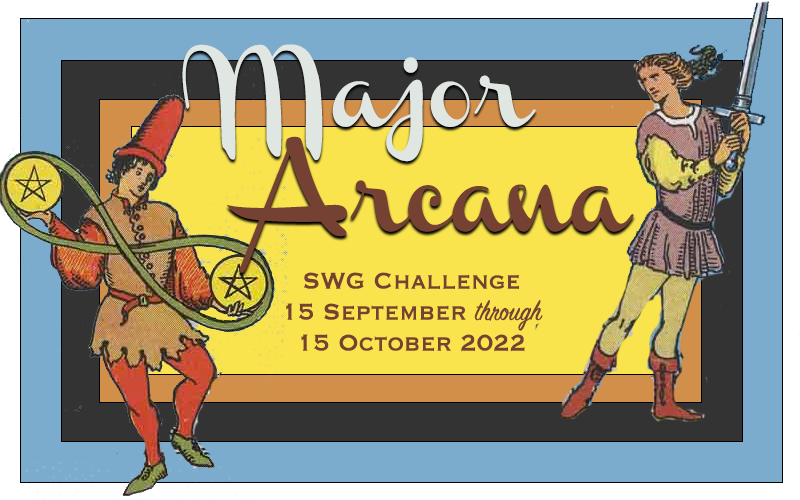
Tarot cards first appeared in the 15th century as playing cards that were later used as well for divination. This month, we draw on the arcane and alluring imagery of the Rider Waite Tarot deck to inspire our fanworks.
You will select a card as your prompt. You can use any aspect of the card's imagery, name, description—found below—or reading (upright or reversed) to inspire your fanwork. Want to let fate decide? Choose a random Tarot card here.
This challenge opened in .
Prompts
Choose your prompt from the collection below.
- View Prompts
-
0. The Fool
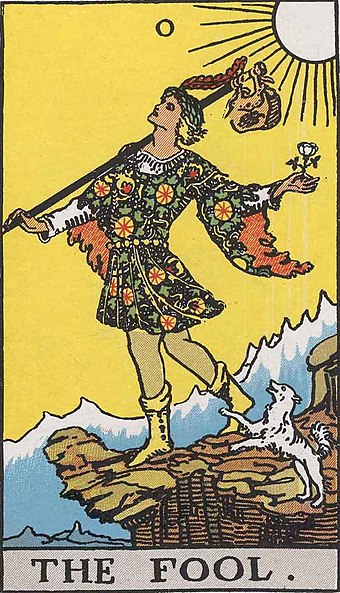
The Fool is shown as a young man, walking unknowingly toward the brink of a precipice. He is also portrayed as having with him a small dog. The Fool holds a white rose (a symbol of freedom from baser desires) in one hand, and in the other a small bundle of possessions, representing untapped collective knowledge. (E. Gray, The Tarot Revealed: A Modern Guide to Reading the Tarot Cards.)
This is either the first (0) or last (22) card of the Major Arcana.
Readings:
Upright: Folly, mania, extravagance, intoxication, delirium, frenzy, bewrayment.
Reversed: Negligence, absence, distribution, carelessness, apathy, nullity, vanity
I. The Magician
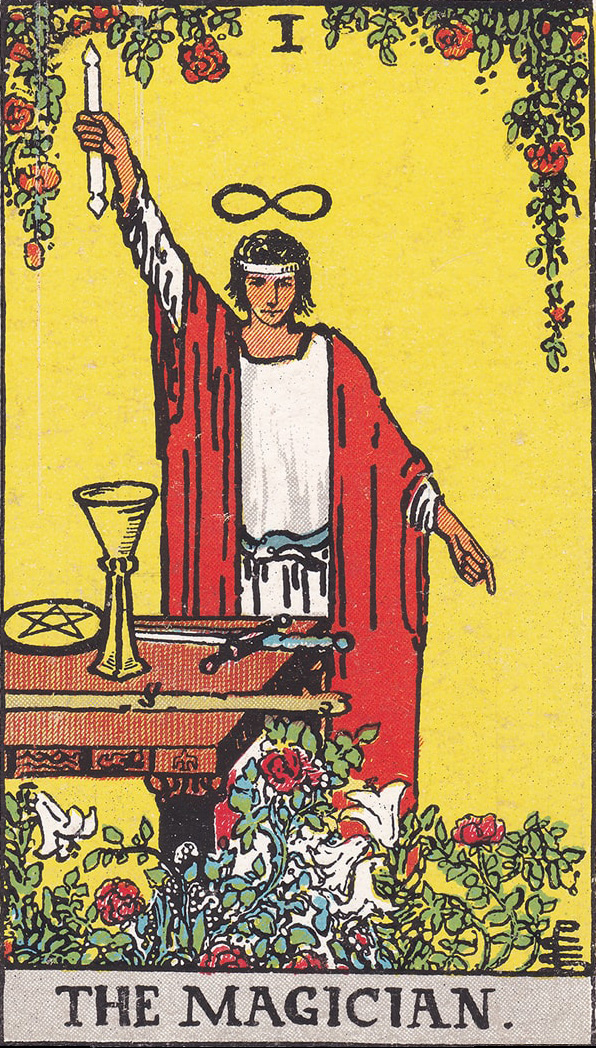
The Magician is depicted with one hand pointing upwards towards the sky and the other pointing down to the earth. On the table before him are a cup, a sword, a wand, and a pentacle. They represent the classical elements of earth, air, fire and water. The Magician's right hand, pointed upwards, holds a double-ended white wand; the ends are interpreted much like the hand gestures, in that they represent the Magician's status as conduit between the spiritual and the physical. His robe is white, a symbol of purity yet also of inexperience, while his mantle is red, understood through the lens of red's wildly polarised colour symbolism—both a representative of willpower and passion, and one of egotism, rage, and revenge. In front of the Magician is a garden of Rose of Sharon roses and lilies of the valley demonstrating the Magician's ability to cultivate and fulfill potential. (Wikipedia) The Roman numeral I is shown at the top of the card.
Readings:
Upright: the divine motive in man; spiritual rebirth; realised potential.
Reversed: “black magick”, madness, mental distress, unfocused/ unmanifested potential.II. The High Priestess
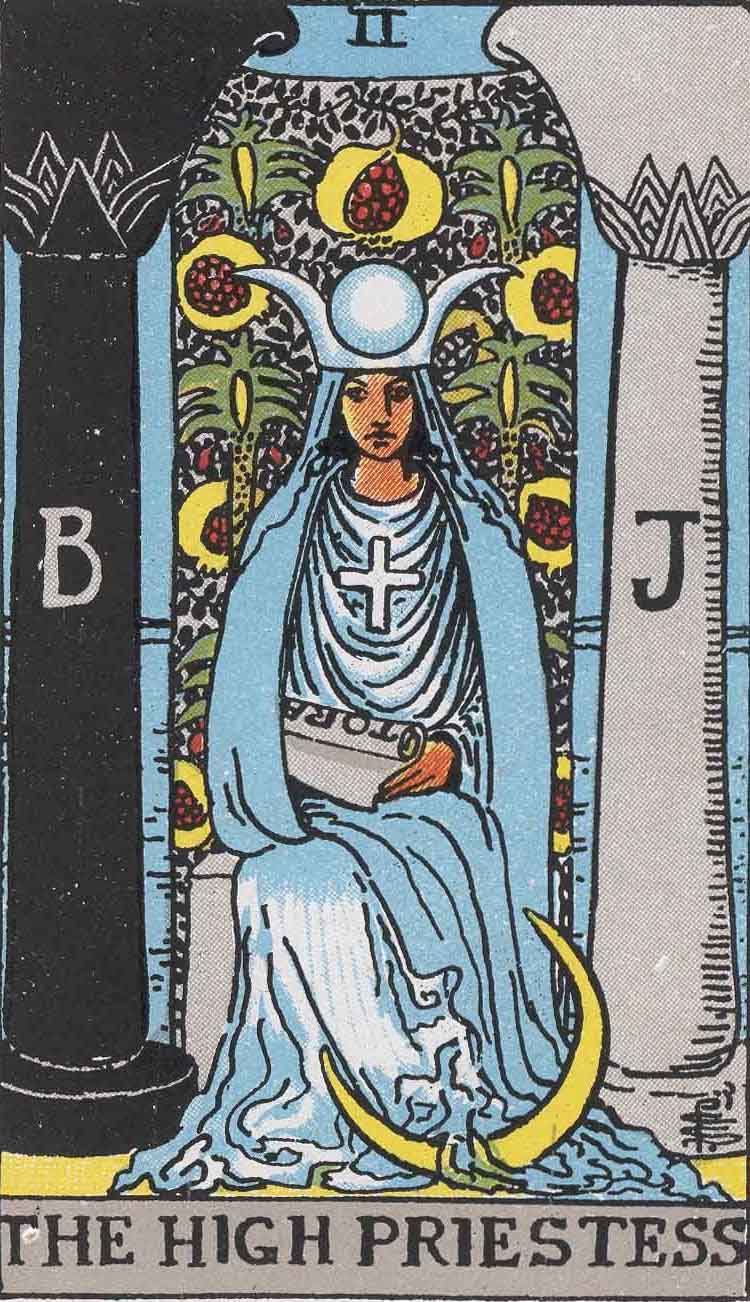
The High Priestess wears plain blue robes with a flowing skirt and sits holding a scroll on her lap. She has a lunar crescent at her feet and a crown on her head with a half-crescent on either side and an orb in the middle, with a veil coming down from the crown. Her face is uncovered and her hair is dark. She looks directly at the viewer. There is a large cross or plus sign on her breast. The scroll in her hand is partly covered by her cloak, but the letters T-O-R-A are visible at the top of it. To the right of the High Priestess is a white pillar bearing a black letter J; to the left, a black pillar bearing a white letter B. There is a hanging behind her seat depicting palm leaves and pomegranates, with a motif of generic leaves behind them. The Roman numeral II is shown at the top of the card.
Readings:
Upright: Secrets, mystery, the future as yet unrevealed; the woman who interests the Querent; the Querent herself; silence, tenacity; mystery, wisdom, science.Reversed: Passion, moral or physical ardour, conceit, surface knowledge.
III. The Empress
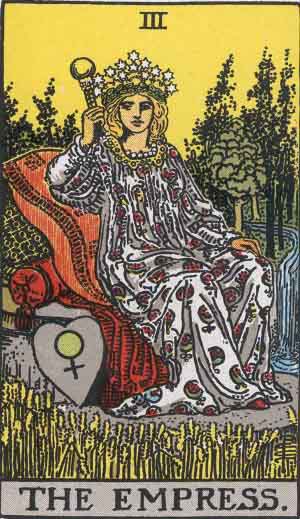
The Empress sits on a cushioned throne. She is wearing a crown with twelve stars, holding a sceptre in one hand. The scepter is representative of her power over life, her crown has twelve stars representing her dominance over the year, and her throne is in the midst of a field of grain, representative of her dominion over growing things. Her white robe is decorated with depictions of pomegranates, with a golden collar. Next to her seat there is a heart-shaped shield with the alchemical symbol for Venus (today better known as the female gender symbol). In the background there are young green trees and a small river and waterfall. The Empress is representative of the productivity of the subconscious, seeded by ideas. She is meant to be the embodiment of the growth of the natural world, fertility, and what one knows or believes from the heart. (Wikipedia) The Roman numeral III is shown at the top of the card.
Readings:
Upright: Fruitfulness, action, initiative, length of days; the unknown, clandestine; also difficulty, doubt, ignorance.
Reversed: Light, truth, the unravelling of involved matters, public rejoicings; according to another reading, vaccilationIV. The Emperor
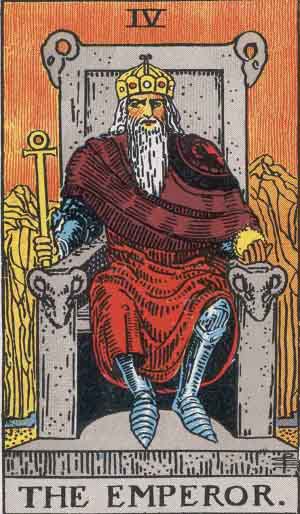
The Emperor sits on a stone throne decorated with ram’s heads, a symbol of Mars. Another ram head can be seen on the shoulder of his cloak. Underneath his red robes he wears plate armour, upon his head is a golden crown with jewels in different colours. He has a long white beard. He holds an Ankh scepter in his right hand, and a globe, symbol of domination, in his left. The Emperor sits atop a stark, barren mountain, a sign of "sterility of regulation, and unyielding power." He symbolizes the top of the secular hierarchy, the ultimate male ego. The Emperor is the absolute ruler of the world. (Wikipedia) The Roman numeral IV is shown at the top of the card.
Readings:
Upright: Stability, power, protection, logic, realization; a great person; aid, reason, conviction also authority and will
Reversed: Benevolence, compassion, credit; also confusion to enemies, obstruction, immaturity.V. The Hierophant
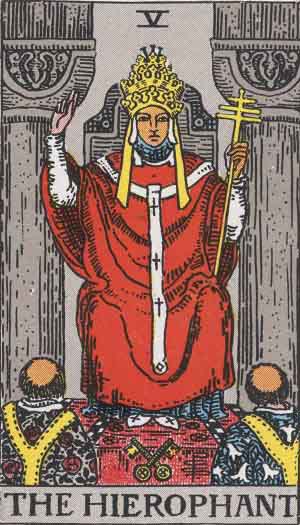
The Hierophant is represented with his right hand raised in blessing or benediction, with two fingers pointing skyward and two pointing down, thus forming a bridge between Heaven and Earth. The Hierophant is thus a true "pontiff", in that he is the builder of the bridge between deity and humanity. In his left hand he holds a triple cross. The Hierophant is typically male, even in decks that take a feminist view of the Tarot. The Hierophant was also known as "The Teacher of Wisdom". In most iconographic depictions, the Hierophant is seen seated on a throne between two pillars symbolizing Law and Liberty or obedience and disobedience, according to different interpretations. He wears a triple crown, and the keys to Heaven are at his feet. Sometimes he is shown with worshippers or lower-ranked priests in the two bottom corners of the card. The card is also known as "The High Priest", as a counterpart to "The High Priestess". (Wikipedia) The Roman numeral V is shown at the top of the card.
Readings:
Upright: Marriage, alliance, captivity, servitude; by another account, mercy, and goodness; inspiration; the person to whom the Querent has recourse.
Reversed: Society, good understanding, concord, over kindness, weakness.VI. The Lovers
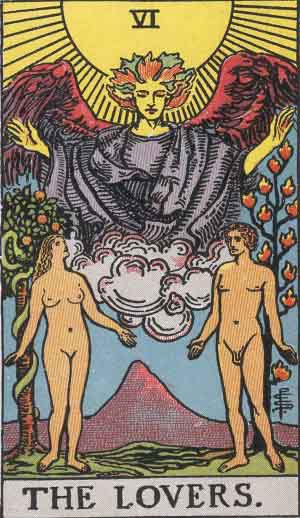
Instead of a couple receiving a blessing from a noble or cleric, the Rider–Waite deck depicts Adam and Eve in the Garden of Eden under the sun in its zenith. They are naked, with a fruit-bearing tree and a snake behind Eve and a tree with flaming fruit behind Adam. In the background, a high cone-shaped mountain rises between them. Above them hovers a large figure with red wings and hair that resembles foliage in red and green. The figure has both arms raised, apparently to pour down influences (but it might also be a gesture of blessing or interception). The symbolism of no return from making bad decisions, and the consequences of innocence lost, would be more widely understood from this imagery. (Wikipedia) The Roman numeral VI is shown at the top of the card.
Readings:
Upright: Attraction, love, beauty, trials overcome
Reversed: Failure, foolish designs. Another account speaks of marriage frustrated and contrarieties of all kinds.VII. The Chariot
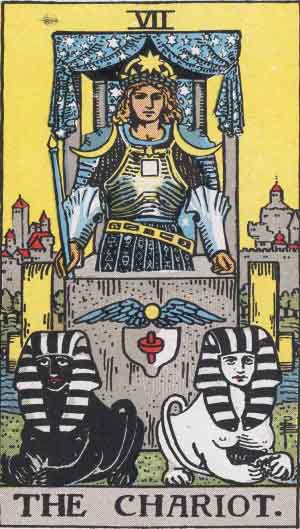
A figure sits in a chariot, although he holds no rope, he is pulled by two sphinxes or horses. There is often a black and white motif, for example one of the steeds may be black and the other white, and one depicted as male and one as female. The figure may be crowned or helmeted and wearing armour, and is winged in some representations. The figure may hold a sword or wand. The mallet, or gavel, on the chariot's coat of arms is a masonic symbol representing self control underneath a winged sun. A canopy of stars above the charioteer's head is intended to show "celestial influences". In the background there is a river or moat and a walled city. (Wikipedia) The Roman numeral VII is shown at the top of the card.
Readings:
Upright: Succour, providence; also war, triumph, presumption, vengeance, trouble.
Reversed: Riot, quarrel, dispute, litigation, defeat.VIII. Strength or Fortitude
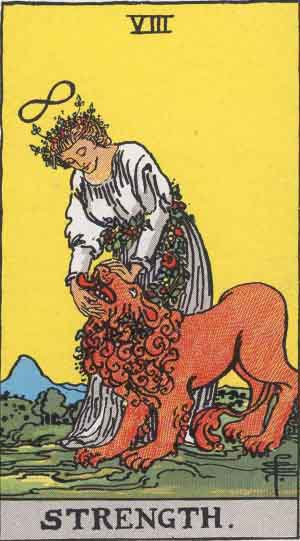
The key characters are that of a woman and a lion, with the woman leaning over the lion. Many cards have the woman clasping the lion's jaws. Some feature an infinity symbol hovering over the woman's head. Other decks have the woman sitting upon the lion, or merely with one hand upon it. The woman is wearing a robe of white as a symbol for purity, and she is crowned and girded with flowers. The background shows a green landscape of hills and trees in front of distant mountains. (Wikipedia) The Roman numeral VIII is shown at the top of the card.
Readings:
Upright: Power, energy, action, courage, magnanimity; also complete success and honours.
Reversed: Despotism, abuse of power, weakness, discord, sometimes even disgrace.IX. The Hermit
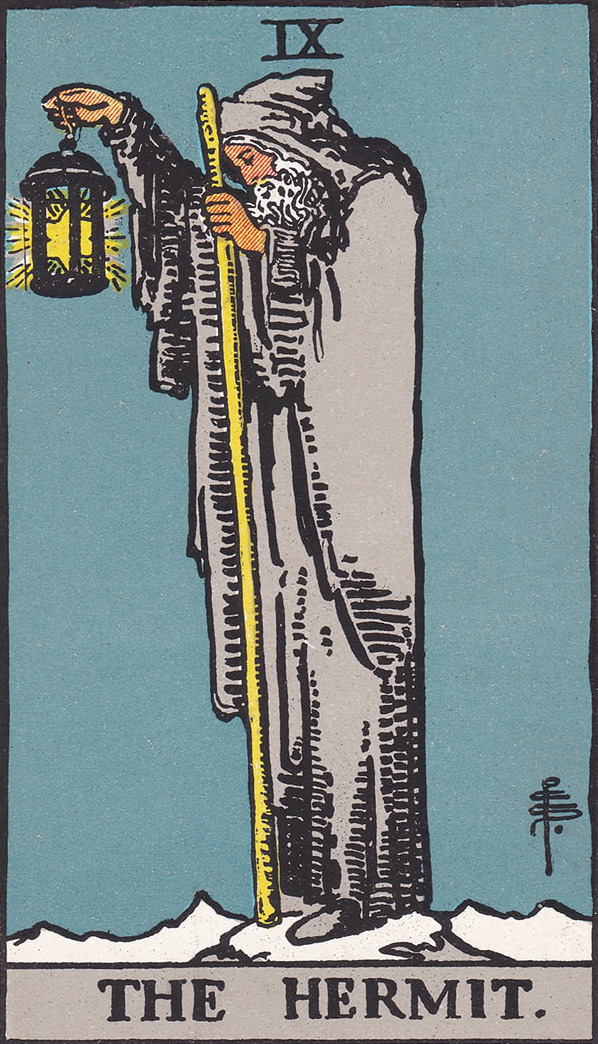
An old man in a grey robe and cloak is standing on a snow-capped mountain peak. He has a long white beard and is wearing the hood of his cloak over his head. He is carrying a staff in one hand and a lit lantern containing a six-pointed star in the other. In the background there is a white mountain range and a clear darkening sky.The card is usually thought to connote aspects of healing/ recovery, particularly the kind that happens over time. In that regard, The Hermit is sometimes considered the mature and wiser version of The Magician. (Wikipedia) The Roman numeral IX is shown at the top of the card.
Readings:
Upright: Prudence, circumspection; also and especially treason, dissimulation, roguery, corruption
Reversed: Concealment, disguise, policy fear, unreasoned caution.X. The Wheel of Fortune
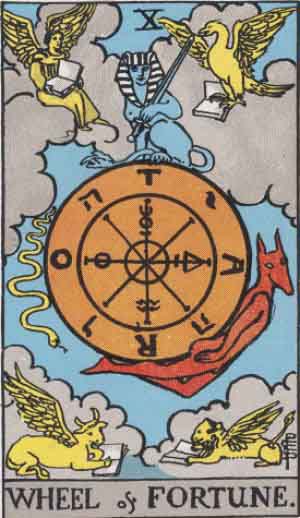
Images generally show a six- or eight-spoked wheel, often attended or crested by an individual (sometimes human; sometimes a Sphinx-like half-human) attired in an Egyptian-style headdress. [...] The wheel is not always shown inscribed with any lettering. Where this is the case, the letters T-A-R-O (clockwise) or T-O-R-A (counter clockwise) can often be found aligned against four of the spokes [...] In some decks, such as the Waite, the wheel is also inscribed with additional alchemical symbols representing the four elements: Earth, Air, Fire and Water [...] There are also four winged creatures in the corners of the card, representing the symbols of the four Evangelists (The Lion, the Ox, the Man and the Eagle). These four Evangelists are also represented by the four fixed astrological signs: Taurus, Leo, Scorpio and Aquarius. In addition a representation of the god Anubis is seen rising with the wheel on the right side, while the snake-like Typhon descends on the left. (Wikipedia) The Roman numeral X is shown at the top of the card.
Readings:
Upright: Destiny, fortune, success, elevation, luck, felicity
Reversed: Increase, abundance, superfluity.XI. Justice
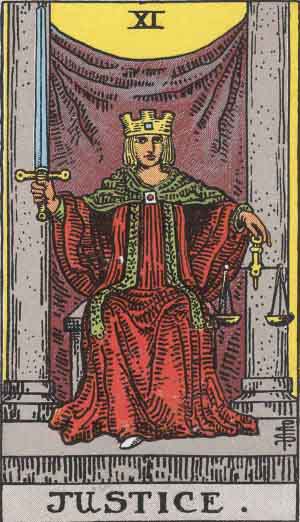
Justice shows a young person with light hair wearing bright red robes with a golden stole and a mural crown with a single gem in the center. One foot peeks out from beneath their robe. Justice looks directly at the viewer. In their right hand is an upraised sword, in their left hand a set of gold scales in balance. There are two grey columns on either side, and a dull red-gray hanging between them. The Roman numeral XI is at the top of the card.
Readings:
Upright: Equity, rightness, probity, executive; triumph of the deserving side in law.
Reversed: Law in all its departments, legal complications, bigotry, bias, excessive severity.XII. The Hanged Man
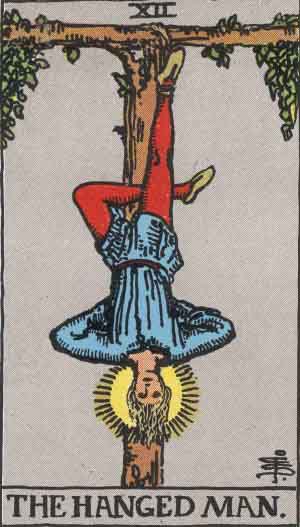
A man hanging upside-down by one foot. The figure is most often suspended from a wooden beam (as in a cross or gallows) or a tree. He is fully clothed and has his hands tied or hidden behind his back. Ambiguity results from the fact that the card itself may be viewed inverted. There is a halo burning brightly around the hanged man's head, signifying a higher learning or an enlightenment. The background is blank. In astrology, the Hanged Man card is associated with the planet Neptune and the Pisces zodiac sign. (Wikipedia) The Roman numeral XII is shown at the top of the card.
Readings:
Upright: Wisdom, circumspection, discernment, trials, sacrifice, intuition, divination, prophecy.
Reversed: Selfishness, the crowd, the body politic.XIII. Death
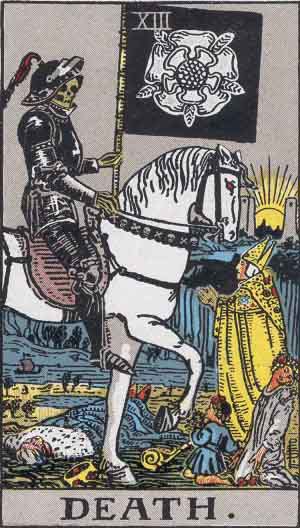
The Death card usually depicts the Grim Reaper, the personification of Death, in the shape of a skeleton in a black suit of armour. In some decks, the Grim Reaper is riding a pale horse with blood-shot eyes, and often he is wielding a sickle or scythe, but in the Rider-Waite tarot deck the skeleton is carrying a black standard emblazoned with a white rose. Surrounding the Grim Reaper are dead and dying people from all classes, including kings, bishops and commoners, some already dead, some on their knees begging to be spared. In the background there is a black ship on the left, and two towers with a setting or rising sun between them on the right. (Wikipedia) The Roman numeral XIII is shown at the top of the card.
Readings:
Upright: End, mortality, destruction, corruption; also, for a man, the loss of a benefactor; for a woman, many contrarieties; for a maid, failure of marriage projects.
Reversed: Inertia, sleep, lethargy, petrifaction, somnambulism; hope destroyedXIV. Temperance
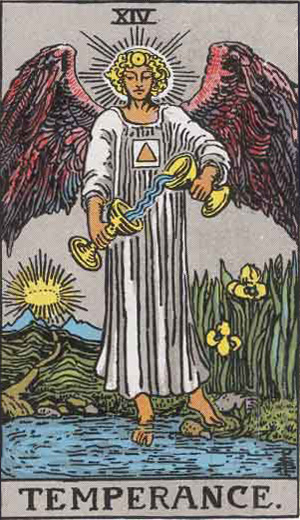
Temperance is almost invariably depicted as a person pouring liquid from one receptacle into another. Historically, this was a standard symbol of the virtue temperance, one of the cardinal virtues, representing the dilution of wine with water. In many decks, the person is a winged angel, usually female or androgynous, and stands with one foot dipping into a pool of water and one foot on land. At the end of the path in the lower left part of the card, there is a crown-like light to show the attainment or mastery of a goal. In the Rider–Waite image by Pamela Coleman-Smith (shown on this page) the Hebrew Tetragrammaton is on the angel's chest above a square and triangle. In the derivative Tarot decks this is usually not included. Yellow Iris are growing next to the winged figure. (Wikipedia) The Roman numeral XIV is shown at the top of the card.
Readings:
Upright: Economy, moderation, frugality, management, accomodation.
Reversed: Things connected with churches, religions, sects, the priesthood, sometimes even the priest who will conduct the querent's marriage; also disunion, unfortunate combinations, competing interests.XV. The Devil
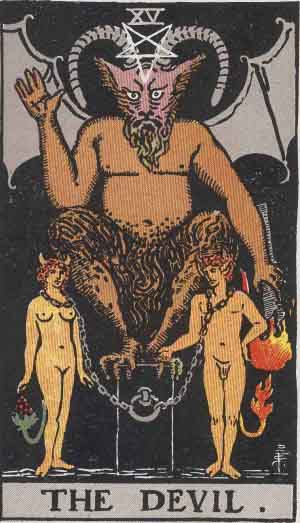
The Devil has harpy feet, ram horns, bat wings, a reversed pentagram on the forehead, a raised right hand and a lowered left hand holding a torch. His face combines human and bestial features, with a cat-like nose and mouth and a shaggy beard. He squats on a square pedestal. Two naked demons (one appearing male, the other female) with tails and horns stand chained to the pedestal. The Devil card is associated with the planet Saturn, and the correlating zodiac Earth sign, Capricorn.(Wikipedia) The Roman numeral XV is shown at the top of the card.
Readings:
Upright: Ravage, violence, vehemence, extraordinary efforts, force, fatality; that which is predestined but is not for this reason evil.
Reversed: Evil fatality, weakness, pettiness, blindness.XVI. The Tower
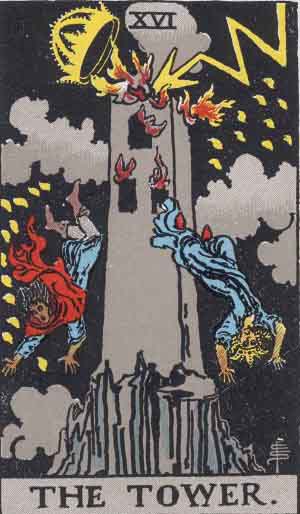
A burning tower on a steep rock is struck by lightning or fire from the sky, its top section in the shape of a crown is dislodged and crumbling. It is surrounded by smoke and small tongues of fire raining down. Two human figures are depicted as jumping or falling down from the crumbling top of the tower, flailing their arms in despair. One is dressed as a commoner with trousers, tunic and short cloak, the other is wearing long robes and a crown. (Wikipedia) The Roman numeral XVI is shown at the top of the card.
Readings:
Upright: Misery, distress, indigence, adversity, calamity, disgrace, deception, ruin. It is a card in particular of unforeseen catastrophe.
Reversed: Negligence, absence, distribution, carelessness, distraction, apathy, nullity, vanity.XVII. The Star
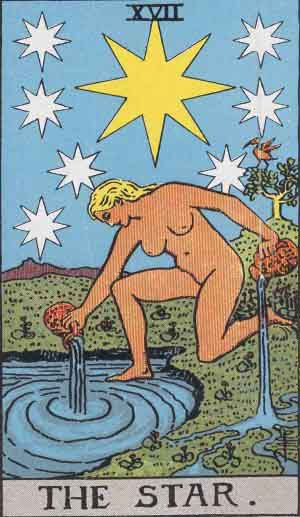
A naked woman with long, lose hair kneels by a pool of water; one foot is in the water and one foot is on the land. Above her head is one large white star with eight rays and seven smaller golden stars, also with eight rays, representing the chakras. In each hand she holds a jug. From one jug she pours a liquid into the water. From the other jug she pours a liquid onto the land. Small herbaceous flowers are growing from the grass. In the background there is a range of mountains and a single green hill with a golden and green tree growing atop. A bird with a long bill and thin legs is sitting in the tree. (Wikipedia) The Roman numeral XVII is shown at the top of the card.
Readings:
Upright: Hope and bright prospects, insight, inspiration, courage and enlightenment of the spiritual self. Body and mind and converging towards the light at the end of a dark time(s).
Reversed: Loss, theft, privation, abandonment; another reading says: arrogance, haughtiness, impotence.XVIII. The Moon
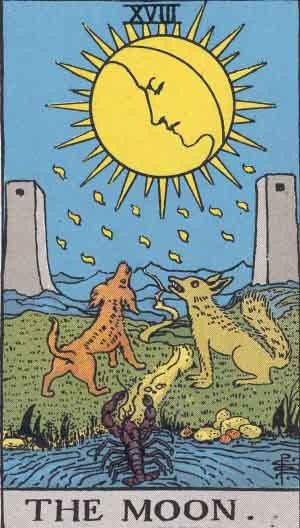
A night scene, where two large pillars or towers rise up between mountains. A wolf and a domesticated dog howl at the waxing moon while a crayfish emerges from the water. The Moon has sixteen chief and sixteen secondary rays and a human face with a serious or sad expression. Tears of fire appear to be raining down from it. In the middle, a path leads from the water to the distant mountains in the background, dividing the lower half of the card between the wolf and the dog, and between the two pillars or towers. (Wikipedia) The Roman numeral XVIII is shown at the top of the card.
Readings:
Upright: Hidden enemies, danger, calumny, darkness, terror, deception, occult forces, error.
Reversed: Instability, inconstancy, silence, lesser degrees of deception and error.XIX. The Sun
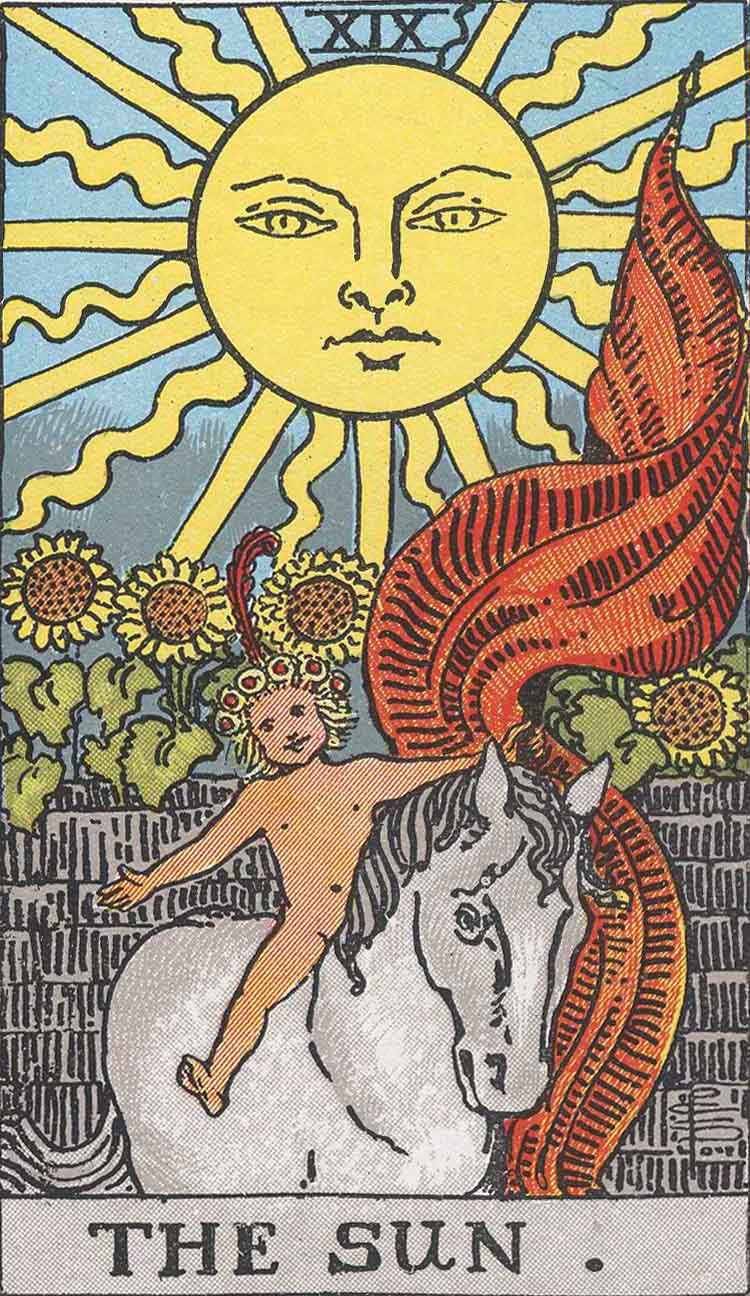
An infant crowned with a flower garland rides a white horse under the Sun, which has a stern human face. There are eleven straight and ten twisting rays emanating from the sun. Sunflowers are growing in the background. The child of life has its arms outstretched. It holds a red flag, representing the blood of renewal and accomplishment, in its left hand. There is a red feather sticking from its flower crown. The expression on the child’s face is one of content happiness. (Wikipedia) The Roman numeral XIX is shown at the top of the card.
Readings:
Upright: Material happiness, fortunate marriage, contentment
Reversed: The same, but in a lesser sense.XX. [The Last] Judgment
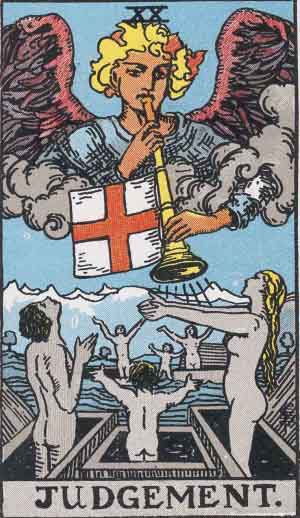
An angel with flames in their hair is depicted blowing a great fanfare, from which hangs the flag of St. George. A group of naked resurrected people (adult and children) with grey skin are standing in their open coffins, arms spread, looking up at the angel in awe. Some of the coffins appear to be floating on the sea, calling back to the Book of Revelation chapter 20, where the sea gives up its dead. There are snow-covered mountains in the background indicating a winter theme, as a symbolical ending. (Wikipedia) The Roman numeral XX is shown at the top of the card.
Readings:
Upright: Judgement, rebirth, inner calling, absolution
Reversed: Self-doubt, inner critic, ignoring the callXXI. The World
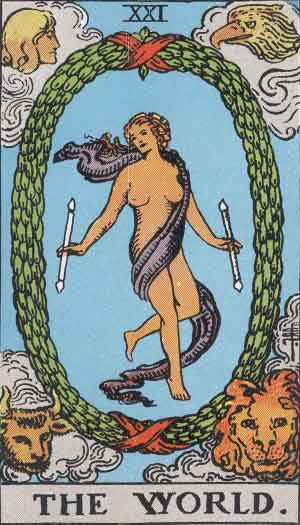
The world is symbolized by a naked woman hovering or dancing above the Earth holding a staff in each hand, surrounded by a wreath wound with red ribbon, being watched by the four living creatures (or hayyoth) of Jewish mythology: a man, a lion, an ox, and an eagle. This depiction parallels the tetramorph used in Christian art. Some astrological sources explain these observers as representatives of the natural world or the kingdom of beasts. According to astrological tradition the Lion is Leo —a fire sign, the Bull or calf is Taurus —an earth sign, the Man is Aquarius —an air sign, and the Eagle is Scorpio —a water sign. Accordingly, these signs represent the classical four elements. In some decks the wreath is an ouroboros (a snake biting its own tail). (Wikipedia) The Roman numeral XXI is shown at the top of the card.
Readings:
Upright: Assured success, recompense, voyage, route, emigration, flight, change of place.
Reversed: Inertia, fixity, stagnation, permanence.
Fanworks Tagged with Major Arcana

All the More Did He Seek Their Friendship by StarSpray
Silver light poured through the windows, catching and refracting on the crystals hung about the room, twinkling like tiny stars. The court of Tirion was particularly splendid that evening, Indis thought as she sat upon the dais beside Finwë, watching the dancing. A rare event: all of their children and grandchildren were present, and even Fëanáro seemed to be in good spirits as he twirled about the floor with Ëarwen.
But still Indis felt uneasy.

The Waters Draw Back by Grundy
Pharazôn has just won a victory for the ages. So why does he feel so unsettled?

Treelight, Moonlight, Sunlight, Starlight by Lferion
Fingon and swimming

A mushroom surprise by daughterofshadows
They've been down on their luck, trying to acquire a silmaril, but maybe this is the sign that things are finally looking up.

Darkened by reindeer_pizza
Written for the Major Arcana Monthly Challenge. I was randomly assigned the Hermit card. An exploration of how Eöl came to be alone in Nan Elmoth, removed from elvish society.

Who Shall Release Us? by polutropos
A re-embodied Maedhros slowly remembers. As he does, he must come to terms with an absence and accept that there are some things he will never know.

The Emperor's Goodbye by Himring
Before his death, Elros has a near-death experience.
Featuring Numenorean bears, just because.

